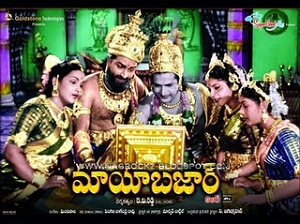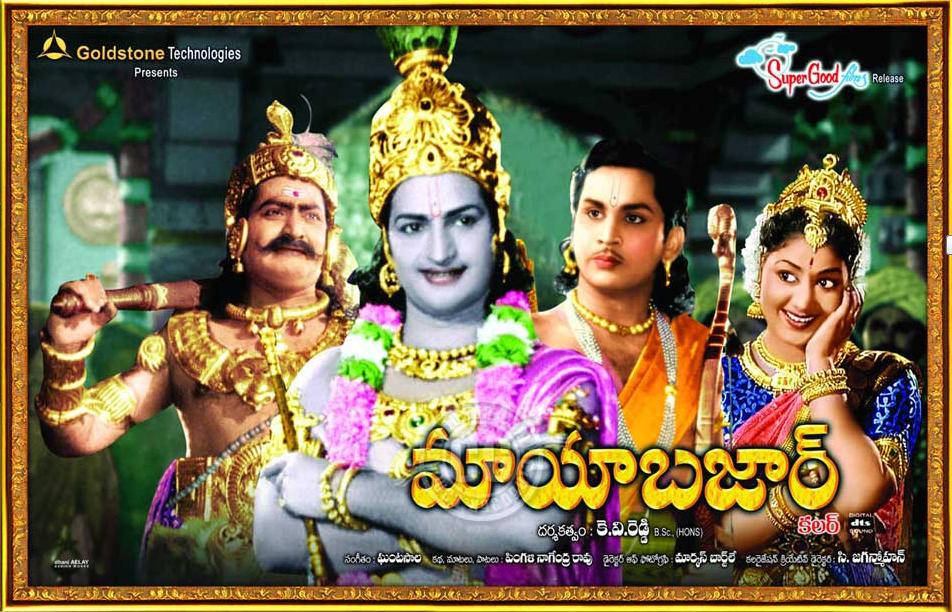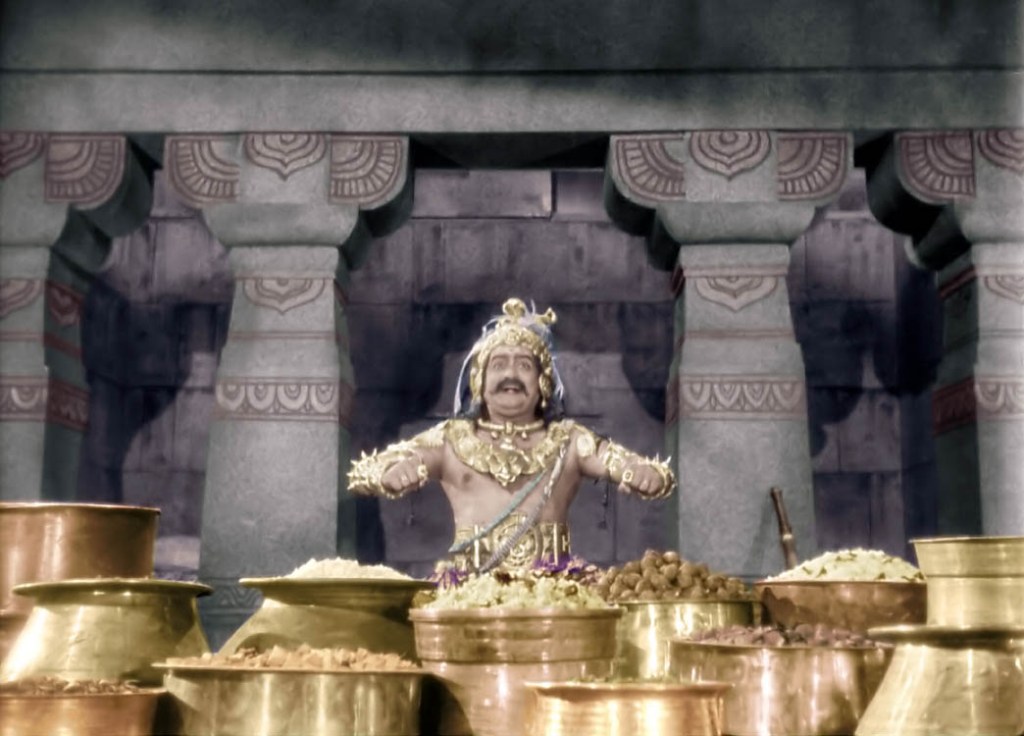Any mention of Telugu Cinema, indeed Indian Cinema itself, would be incomplete without reference to the inimitable 1957 epic Family Drama & Comedy Maya Bazaar.
Without a doubt the most beloved Telugu movie of all time, it is the quintessential Andhra approach to the Mahabharata. Much like our irreverent culture of wit, this classic was a light-hearted take on the otherwise serious subject matter from India’s eponymous National Epic (the initials of which it coincidentally shares).
Interestingly, though it was released 6 years later, Maya Bazaar retains nearly an identical production team as our previous classic Paathaala Bhairavi. If Paathaala Bhairavi was a pioneering work, then Maya Bazaar was a masterful one.
Story
One of the unique feats of Maya Bazaar was to honestly treat what is likely the most analyzed and re-told work in classical Indic literature on the basis of the vibrant folk artforms of the Dakshinapatha. Simultaneously attributed to the Harikatha tradition of Andhra and the plays of Maharashtra/Karnataka, this rendition of Ancient India’s magnum opus relied on them as the source material for post-colonial AP’s magnum opus. Indeed, it is emblematic of the importance of the theater as an institution of high culture. One wonders why drama remains so neglected in (post)-modern India, especially given the sophisticated corpus of Sanskrit plays.
While this episode regarding Abhimanyu’s marriage to Sasirekha is not strictly canon per the authoritative Vyasa original, it nevertheless manages to remain in harmony with the authentic edition, whatever the veracity of the content. What’s more, it takes this Civilizational masterpiece and presents it in a uniquely Telugu tradition of cheeky humor and sophistication, with a heart of gold (or culture without condescension, as we at ACP like to call it). Indeed, none represents this more than the commanding characterization of Ghatotkacha by Sri S.V. Ranga Rao.
Maya Bazaar manages to give us insight into how a powerful, terrible, and even fearsome Rakshasa like the son of Hidimbi and Bhima, could have fought on the side of Dharma and nobly sacrificed his life for his father and uncles. We see in this movie a vision of a mighty warrior with a particular joie de vivre and just sense of loyalty to his family and the good. Whatever his proclivities and magical Asuric powers, in this Ghatotkacha we see an ideal-type of the Rakshasa much closer to Vibhishana than Ravana–though with a healthy dose of Kumbakarna’s legendary appetite…Verily, those who are born in contravening cultures and yet nevertheless choose the side of Dharma, are considered even greater than regular devotees, reflected in Ghatotkacha’s relationship with Lord Krishna.

Therein lies another aspect of the genius of director Kadri Venkata Reddy’s greatest work: skillful incorporation of philosophy with story. In a particularly illuminating scene, that is the source of social media humor, a mirror device shows the person who thinks of Krishna the most is in fact his scheming antagonist, the prince of Gandhara. Because he is ever fearful of Krishna the strategist, expert dice-player and manipulator Shakuni is constantly meditating on the Lord in his mind.
This in turn demonstrates that what matters most to God is not what name we use to address, or what relational role we most consider, but whether we think of God at all. Admittedly Shakuni is a villain, not only to the Pandavas, whose kingdom he tricks them out of, but even to the House of Kuru itself. But while meditation on God may not save him from his own Karma in this life, it lays the seeds for his own salvation in the future. That is the brilliance of this Bazaar of Maya, for even in its objects of illusion, it reveals Truth.
Production
This film managed what few “phillims” manage to do, which is to deftly weave comedy with serious subject matter. All the leads from the NTR as the coyly knowing Krishna to the reluctantly manipulated Balarama to the ambitious Revathi contribute to the tapestry of this Andhra work of cinematic art. However, none managed this better in that era than Relangi, best seen in the knee-slapping wedding scene, wherein Ghatotkacha wreaks illusory havoc on Lakshmana Kumara (unrequited suitor and erstwhile Bridegroom of Sasirekha).
(comedy starts at 1:40)
At the heart of this production, however, is the Romantic, not only in the literary sense, i.e. Abhimanyu & Ghatotkacha as dashing heroic warriors (“Hai, Hai Nayaka“), but the inherent Sringara rasa. The trials and tribulations facing Sasirekha and her lover, the son of Subhadra & Arjuna, punctuates the story. Indeed, the iconic boat scene in the Lahiri Lo song (see below) remind all of us jaded by this distinctly unromantic era what real romance is really all about. However, it is the sweet melody of the song Neekosame (for you only) that best captures the inherent struggle of star-crossed lovers, sundered by fate and the machinations of others.
Digitally remastered in 2010, the color version of Maya Bazaar managed to take what was state of the art sets and special effects and transform them into a visual feast for the eyes–an ocular “bhojanambu” if you will (non-Telugus, read on and you’ll see what we mean)
Songs
While its unmatched all-star cast of NT Rama Rao, Akkineni Nageshwara Rao, Savithri, Gummadi, and Relangi all compete with one another in their performances, it is ultimately S.V.Ranga Rao who steals the show for all time. Without a doubt, his rendition of Ghatotkacha as a powerful, lovable, and loyal gourmand beats in the hearts of all Telugus to this day. Young & Old, Seemandhrite & Telanganite, Indian & Non-Indian alike cannot help but smile as he carries the entire scene and song on his own–with the delectable Wedding Meal i.e. “Vivaha Bhojambu” as his only celluloid rival and accompaniment. But why attempt to further describe what words will fall short of doing when you can see for yourselves. Enjoy!
Other songs include the more Reverie-Romantic:
To the unabashedly celebratory:
And of course the comic: Sundari oho Sundari, by that ever-reliable source of bathos, Relangi (who plays romantic rival to Abhimanyu)
Ultimately what makes Maya Bazaar authentically classic Cinema is not scale of the set or slick production values, but the integrity and sincerity of the film in presenting the story with open-mindedness, honesty, and artistry. It can reinvent, relocate and reframe a traditional work, and even take liberties with it, but without doing violence to the essence of the inspirational oeuvre or the internal logic of the subject-matter.
Tollywood (and Bollywood) directors would be well-advised not to simply remake such movies (or stories) but to revive, revitalize, and reinvent for the times; to restore, much like the artists hired to individually paint each frame of this film: in a way that adds luster and luminescence, without lasciviousness. Unlike much of the alleged “#TrueCinema” of today (which borders on simulacra) Maya Bazaar did what real cinema does best: evoke the soul, culture, and spirit of a civilization through a body of celluloid art.
Cast
Taraka Rama Rao Nandamuri – Lord Krishna
S.V. Ranga Rao – Ghatotkacha
Savitri – Sasirekha
Akkineni Nageshwara Rao – Abhimanyu
Rushyendramani – Subhadra
Chilakalpudi Seeta Rama Anjaneyulu – Shakuni
Relangi Venkatramaiah – Lakshmana Kumara
Gummadi – Balarama
Sandhya – Rukmini
Chhaya Devi – Revathi
Suryakantham – Hidimbi
Nagabhushanam- Satyaki
Ramana Reddy – Chinnamaya
Mukkamala – Duryodhana
Mikkilineni – Karna
Language:
Original: Telugu
Remakes: Tamil & Hindi
Dubbed: Kannada
Release Date:
27 March 1957 (India)
Runtime:
Director:
Kadri Venkata Reddy
Writers:
Kamalakara, Kameshwara Rao & Pingali, Nagendra Rao
Producers:
Chakrapani & B. Nagi Reddy
Music:
Ghantasala, Venkateswara Rao & Saluri, Rajeshwara Rao
Cinematography:
Marcus Bartley
Art Direction:
Madhavapeddi Gokhale
Color:
Black and White | Color
References:
- http://www.thehindu.com/todays-paper/tp-features/tp-fridayreview/maya-bazaar-forever/article3217898.ece
- Bandyopadhyay, I. A Study In Folk Mahabharata. 2011
- http://www.imdb.com/title/tt0249795/
- http://www.thehindu.com/thehindu/fr/2005/09/16/stories/2005091602010300.htm









Wonderful review. Sweet language with perfect grammar. As good as the script of Maya Bazar. Your advice to producers/directors is in good spirit. The subtle humor you employed is appreciable.